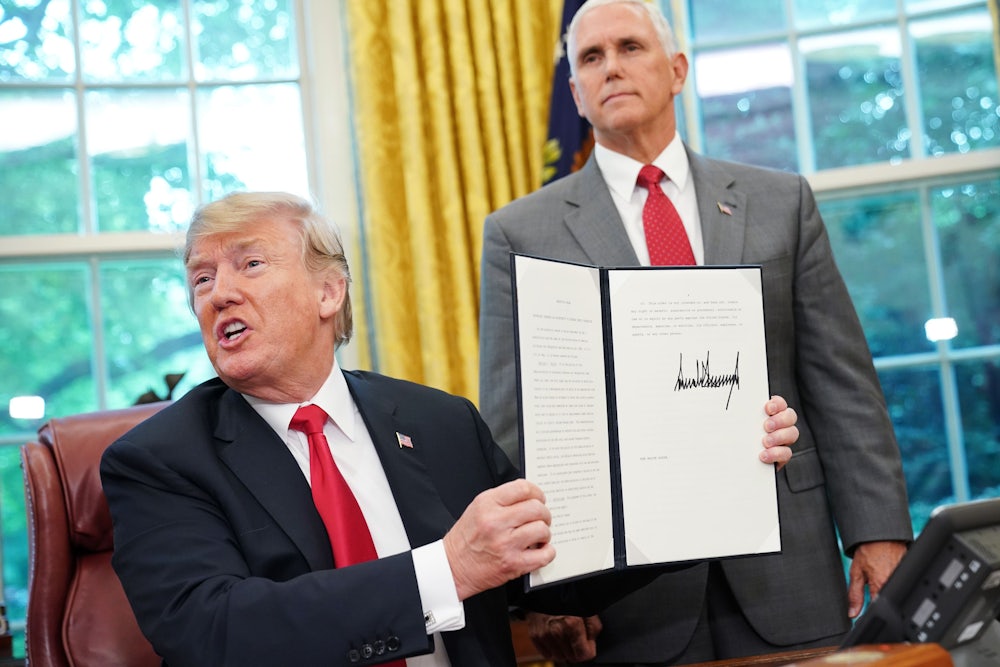President Donald Trump rarely caves to his critics, especially when it comes to the anti-immigration policies that form the core of his agenda. His proposed travel ban targeting Muslim-majority countries drew widespread condemnation last year, but he refused to back down, rewriting the proposal twice so that it might withstand judicial scrutiny. He also continues to insist that Congress provide substantial funding for his border wall, threatening on Monday to shut down the government this fall if he doesn’t get his way.
But the uproar caused by his policy of separating migrant children from their parents, and locking them in cages, proved too much for the famously stubborn president. Even congressional Republicans, who rarely offer substantive pushback to Trump, began working on legislation to reverse it. So on Wednesday he signed a new executive order, passive-aggressively titled “Affording Congress an Opportunity to Address Family Separation,” which instructs immigration officials to “maintain family unity, including by detaining alien families together where appropriate and consistent with law and available resources.”
In theory, that means families who are apprehended after crossing the border illegally will now be detained together instead of separately. However, the order does not outline efforts to reunite the thousands of families who have been broken apart recently, nor does it indicate how long migrant families going forward will be detained. It appears the administration is seeking the right to detain them indefinitely.
The courts will have their say, though this time it’s because the administration is actively seeking judicial clarity rather than being forced to defend itself against lawsuits. Trump’s order calls for the Justice Department to ask a federal court in California to modify a 1997 consent decree known as the Flores agreement, which outlines how long the federal government can detain migrant children, to allow the government “to detain alien families together throughout the pendency of criminal proceedings for improper entry or any removal or other immigration proceedings.”
Changing the Flores agreement would be a notable change in federal immigration policy. As Vox’s Dara Lind and Dylan Scott recently noted, the agreement was the result of a legal battle over the treatment of migrant children in the 1980s, and its terms require federal officials to keep those children in the “least restrictive setting” possible for as little time as possible with adequate access to food, water, and medical care.
The Trump administration has cited the Flores agreement as an obstacle that forced it to pursue family separation. In 2016, the Ninth Circuit Court of Appeals ruled that immigrant children could only be detained for 20 days before they must be released. But earlier this year, Attorney General Jeff Sessions announced the administration’s zero-tolerance immigration policy, which requires federal prosecutors to seek criminal charges against anyone who crosses the U.S. border with Mexico without authorization. Because every adult who is caught crossing the border illegally is now being detained and prosecuted, and children cannot be housed in U.S. jails, the Trump administration says it had no choice but to separate the families.
This is a false choice, however. Officials could simply release migrants pending their immigration hearings, as past administrations have done. BuzzFeed’s John Stanton noted that, contrary to the administration’s hyperbole about lawlessness at the border, almost 90 percent of released migrants appear for their hearings.
Detaining families indefinitely is a solution in search of a problem. Depsite claims by AG Sessions et al that releasing migrants is de facto amnesty, federal data shows the vast majority of people released show up for their immigration hearings.https://t.co/QZNqg6FeaP pic.twitter.com/K9ppXXxOTL
— john r stanton (@dcbigjohn) June 20, 2018
By seeking to modify Flores in federal court, Trump will force one of two outcomes. If successful, he will have a modicum of judicial cover for indefinite detention of migrant families. If unsuccessful, he can blame the judges responsible for that decision, as he has done so many times before. The overall policy—using cruel and draconian measures to deter asylum-seekers from traveling to the United States—would remain intact.
“The devil is in the details,” Anthony Romero, the ACLU’s executive director, said in a statement. “This crisis will not abate until each and every single child is reunited with his or her parent. An eleventh-hour executive order doesn’t fix the calamitous harm done to thousands of children and their parents. This executive order would replace one crisis for another.”
Trump’s executive order is not a policy solution for the resurgent migrant crisis. It’s a slapdash legal gambit that, even if it survives judicial scrutiny, may well create a horror of another sort: massive concentration camps on America’s southern border. But if that happens, Trump already knows who to blame. “It is unfortunate,” his order says, “that Congress’s failure to act and court orders have put the Administration in the position of separating alien families to effectively enforce the law.” In reality, Trump bears full responsibility for the cruelties being committed to enforce his immigration policy. And if his latest move creates yet new cruelties, those will be on his head, too.
